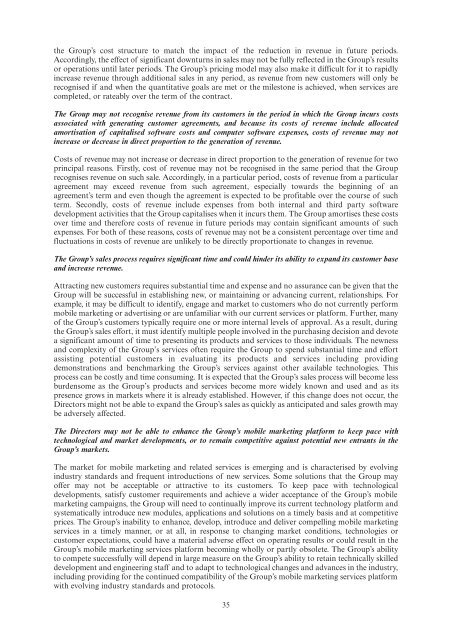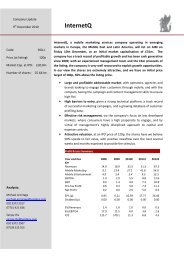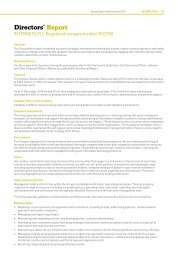Link to Admission Document - InternetQ
Link to Admission Document - InternetQ
Link to Admission Document - InternetQ
You also want an ePaper? Increase the reach of your titles
YUMPU automatically turns print PDFs into web optimized ePapers that Google loves.
the Group’s cost structure <strong>to</strong> match the impact of the reduction in revenue in future periods.Accordingly, the effect of significant downturns in sales may not be fully reflected in the Group’s resultsor operations until later periods. The Group’s pricing model may also make it difficult for it <strong>to</strong> rapidlyincrease revenue through additional sales in any period, as revenue from new cus<strong>to</strong>mers will only berecognised if and when the quantitative goals are met or the miles<strong>to</strong>ne is achieved, when services arecompleted, or rateably over the term of the contract.The Group may not recognise revenue from its cus<strong>to</strong>mers in the period in which the Group incurs costsassociated with generating cus<strong>to</strong>mer agreements, and because its costs of revenue include allocatedamortisation of capitalised software costs and computer software expenses, costs of revenue may notincrease or decrease in direct proportion <strong>to</strong> the generation of revenue.Costs of revenue may not increase or decrease in direct proportion <strong>to</strong> the generation of revenue for twoprincipal reasons. Firstly, cost of revenue may not be recognised in the same period that the Grouprecognises revenue on such sale. Accordingly, in a particular period, costs of revenue from a particularagreement may exceed revenue from such agreement, especially <strong>to</strong>wards the beginning of anagreement’s term and even though the agreement is expected <strong>to</strong> be profitable over the course of suchterm. Secondly, costs of revenue include expenses from both internal and third party softwaredevelopment activities that the Group capitalises when it incurs them. The Group amortises these costsover time and therefore costs of revenue in future periods may contain significant amounts of suchexpenses. For both of these reasons, costs of revenue may not be a consistent percentage over time andfluctuations in costs of revenue are unlikely <strong>to</strong> be directly proportionate <strong>to</strong> changes in revenue.The Group’s sales process requires significant time and could hinder its ability <strong>to</strong> expand its cus<strong>to</strong>mer baseand increase revenue.Attracting new cus<strong>to</strong>mers requires substantial time and expense and no assurance can be given that theGroup will be successful in establishing new, or maintaining or advancing current, relationships. Forexample, it may be difficult <strong>to</strong> identify, engage and market <strong>to</strong> cus<strong>to</strong>mers who do not currently performmobile marketing or advertising or are unfamiliar with our current services or platform. Further, manyof the Group’s cus<strong>to</strong>mers typically require one or more internal levels of approval. As a result, duringthe Group’s sales effort, it must identify multiple people involved in the purchasing decision and devotea significant amount of time <strong>to</strong> presenting its products and services <strong>to</strong> those individuals. The newnessand complexity of the Group’s services often require the Group <strong>to</strong> spend substantial time and effortassisting potential cus<strong>to</strong>mers in evaluating its products and services including providingdemonstrations and benchmarking the Group’s services against other available technologies. Thisprocess can be costly and time consuming. It is expected that the Group’s sales process will become lessburdensome as the Group’s products and services become more widely known and used and as itspresence grows in markets where it is already established. However, if this change does not occur, theDirec<strong>to</strong>rs might not be able <strong>to</strong> expand the Group’s sales as quickly as anticipated and sales growth maybe adversely affected.The Direc<strong>to</strong>rs may not be able <strong>to</strong> enhance the Group’s mobile marketing platform <strong>to</strong> keep pace withtechnological and market developments, or <strong>to</strong> remain competitive against potential new entrants in theGroup’s markets.The market for mobile marketing and related services is emerging and is characterised by evolvingindustry standards and frequent introductions of new services. Some solutions that the Group mayoffer may not be acceptable or attractive <strong>to</strong> its cus<strong>to</strong>mers. To keep pace with technologicaldevelopments, satisfy cus<strong>to</strong>mer requirements and achieve a wider acceptance of the Group’s mobilemarketing campaigns, the Group will need <strong>to</strong> continually improve its current technology platform andsystematically introduce new modules, applications and solutions on a timely basis and at competitiveprices. The Group’s inability <strong>to</strong> enhance, develop, introduce and deliver compelling mobile marketingservices in a timely manner, or at all, in response <strong>to</strong> changing market conditions, technologies orcus<strong>to</strong>mer expectations, could have a material adverse effect on operating results or could result in theGroup’s mobile marketing services platform becoming wholly or partly obsolete. The Group’s ability<strong>to</strong> compete successfully will depend in large measure on the Group’s ability <strong>to</strong> retain technically skilleddevelopment and engineering staff and <strong>to</strong> adapt <strong>to</strong> technological changes and advances in the industry,including providing for the continued compatibility of the Group’s mobile marketing services platformwith evolving industry standards and pro<strong>to</strong>cols.35





